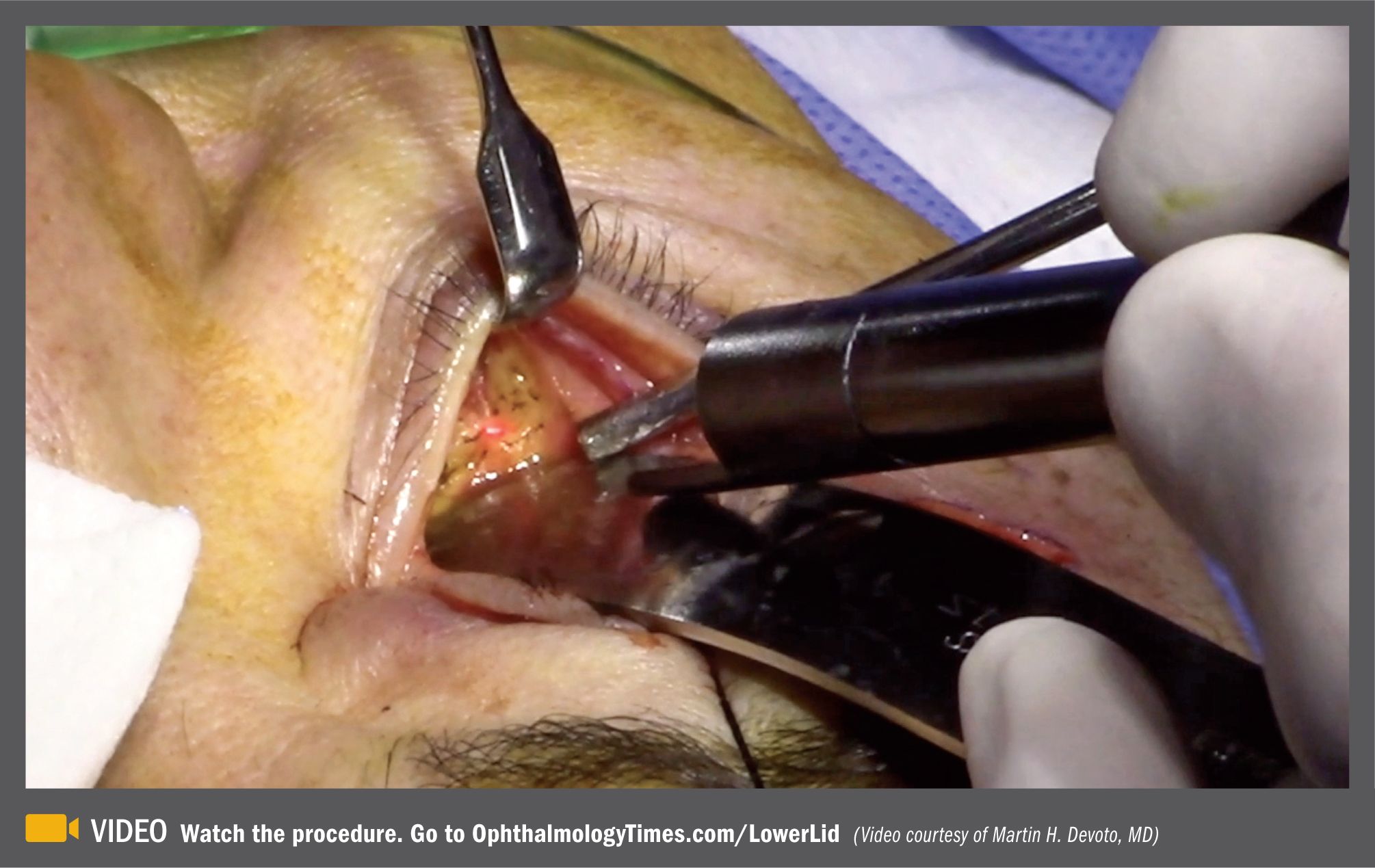- COVID-19
- Biosimilars
- Cataract Therapeutics
- DME
- Gene Therapy
- Workplace
- Ptosis
- Optic Relief
- Imaging
- Geographic Atrophy
- AMD
- Presbyopia
- Ocular Surface Disease
- Practice Management
- Pediatrics
- Surgery
- Therapeutics
- Optometry
- Retina
- Cataract
- Pharmacy
- IOL
- Dry Eye
- Understanding Antibiotic Resistance
- Refractive
- Cornea
- Glaucoma
- OCT
- Ocular Allergy
- Clinical Diagnosis
- Technology
Three-step surgery allays aging, fatigue in lower lid procedure
Dual-plane blepharoplasty can improve tear trough, skin, lower lid position

Lower lid blepharoplasty is one of the most complex facial cosmetic procedures performed, in contrast to upper lid blepharoplasty. Martin H. Devoto, MD, shares his surgical pearls.
Reviewed by Martin H. Devoto, MD
In contrast to upper lid blepharoplasty-which is considered a surgically simple procedure when given the appropriate attention to detail-that of the lower lid is one of the most complex facial cosmetic procedures performed, said Martin H. Devoto, MD.
With aging and fatigue reflected in the lower eyelid area, the key elements to achieving a youthful contour in the lower lid is providing a short vertical lower lid.
“After each decade, the length of the lower lid increases,” explained Dr. Devoto, director, Oculoplastics and Orbital Surgery Division, Consultores Oftalmologicos, Buenos Aires, Argentina.
“A short lower lid is a sign of youth.” Another element is the preservation and enhancement of the shape of the lower lid. In younger patients, the lateral canthal angle of the lower lid is higher than the medial compared with older patients. The final element that should be enhanced is the quality of the skin, he noted.
Three parts
To reach these goals, Dr. Devoto and colleagues perform a three-part combination procedure-the dual-plane blepharoplasty.
- The first part is improving the tear trough with fat transposition.
- The second part is tightening the orbicularis muscle to improve laxity by placing a stitch that is passed from the superior incision above when performing an upper lid blepharoplasty or by making a separate stab incision, grasping the orbicularis muscle, and tightening it to the upper lid.
- The third component is improving wrinkles using a skin-pinching technique, which preserves the orbicular muscle function and innervation by avoiding cutting the muscle, Dr. Devoto explained.
Dr. Devoto makes a cut with a monopolar needle or CO2 laser after the lower lid is retracted. He performs the dissection in front of the septum to avoid bulging of the fat.
Dr. Devoto notes the importance of placing a corneal shield, but before that, he puts a stitch in the conjunctiva and places retractors for better exposure. He dissects inferior to the arcus marginalis, for about 10 mm and completely release the orbital retaining ligament. He advises paying attention to the exit point of the infraorbital nerve, and the dissection can be aided using a cotton swab.
When the pocket is formed, the medial and central fat pads are released in pedicules and freed using Wescott scissors. A 5-0 nylon suture is inserted about 10 mms below the premarked arcus marginalis.
The suture goes under the dissected flap and it is used to engage the medial and central fat pads to create a “curtain” of fat. The fat creates a layer that will hold and help elevate the tear trough, Dr. Devoto explained. The exit point is located slightly nasally.
A pearl at this point is to avoid overtightening the 5-0 nylon stitch, which is removed 1 week postoperatively. The lateral fat pad can be transposed in some patients, but in these cases, a dissection is necessary in the lateral area. However, this increases the degree of chemosis.
Because of this, he usually opts to excise this fat. A final step in the procedure is pinching of the skin, which is removed with a Wescott scissors to the point of the inferior punctum. To raise the orbicularis muscle, he engages the periosteum by passing a suture, which goes beneath the orbicular muscle and exits through pinched tissue to produce a mild elevation of the canthal elevation. The knot is buried under the orbicularis muscle.
“The key points in this procedure are marking the extent of the tear trough and dissecting and releasing of the entire tear trough, careful and complete release of the fat pedicles with no or partial excision to avoid tension, and identification of the inferior oblique muscle to make sure the medial and central fat pockets are not attached to the muscle,” he said.
Dr. Devoto and colleagues conducted a study that included 200 consecutive patients who underwent this procedure in two centers in Argentina and Italy performed by two surgeons (Dr. Devoto and Dr. Francesco Bernardini, MD). An oculoplastics specialist evaluated the changes in the tear trough and a dermatologist assessed the changes in wrinkling on photographs from preoperatively to postoperatively.
The changes in the lower lid position were analyzed using validated software and compared with controls who ranged in age from 25 to 35 years. “Using the software, we were able to show that the distance in the eyelid margin decreased significantly [p < 0.05] after surgery in both the vertical mid-pupillary distance and the medial and lateral radius,” he said. Ninety percent of patients had skin improvement; 96% had tear trough improvement; and 75% had good to excellent outcomes.
Complications can include remaining bags under the eyes, irregularities in the correction, and insufficient transposition of the tear trough. “The dual-plane blepharoplasty can improve the tear trough, the skin, and the lower lid position,” Dr. Devoto concluded.
Disclosures:
Martin H. Devoto, MD
E: martindevoto@gmail.com
This article was adapted from Dr. Devoto’s presentation during Oculoplastics Subspecialty Day at the 2018 meeting of the American Academy of Ophthalmology. Dr. Devoto has no financial interest in any aspect of this report.
